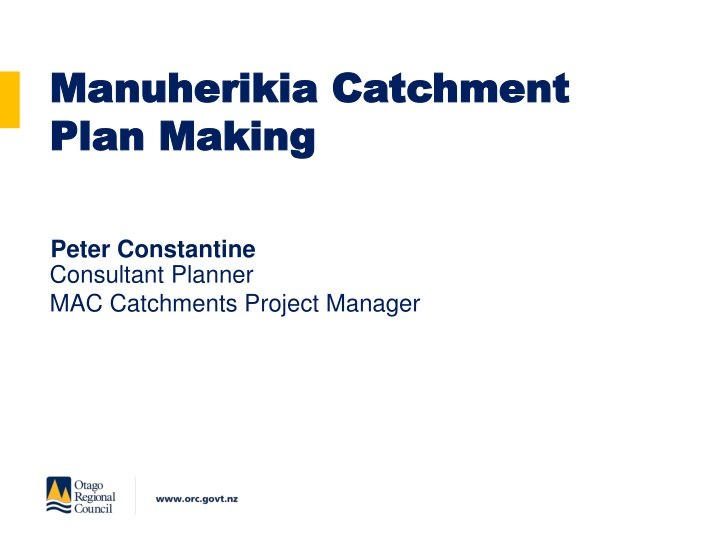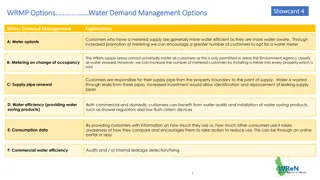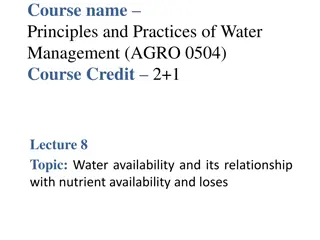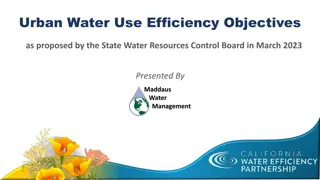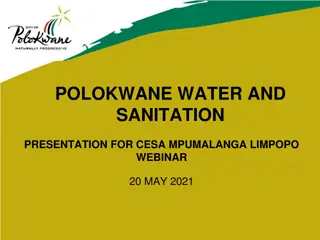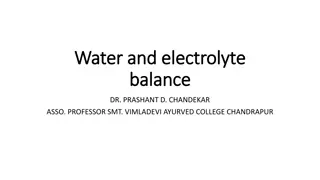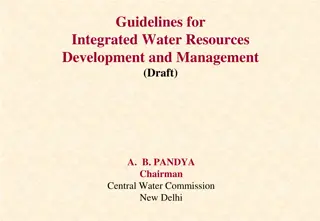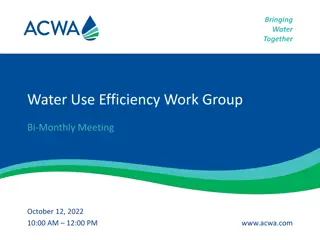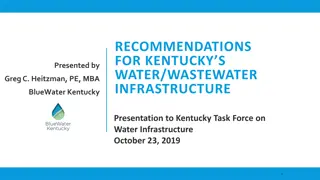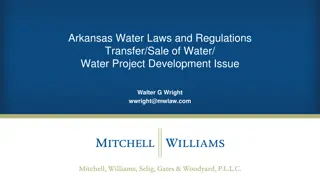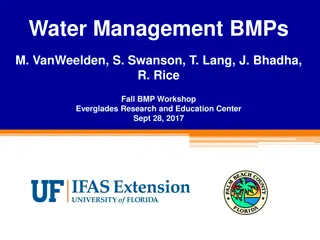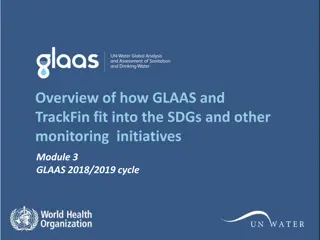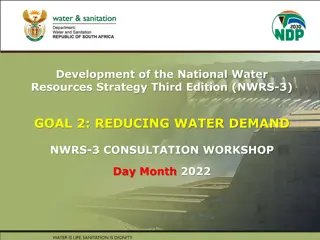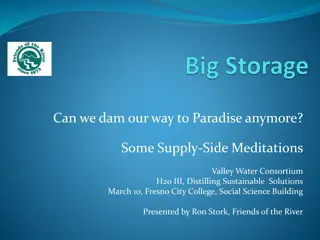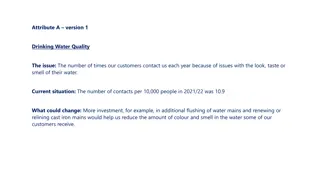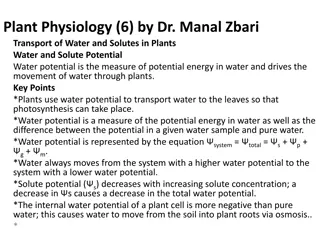Challenges in Water Management: Achieving Balance
Effective management of water resources is essential to sustain a balance between environmental preservation and consumptive needs. This involves addressing complexities such as changing behaviors, sustainability, and equity while improving water quality and ensuring sustainable practices in an arid environment. Key drivers, as outlined in the RMA, emphasize sustainable management, stewardship, and the preservation of ecosystems, highlighting the importance of Maori cultural connections and the Treaty of Waitangi principles in decision-making.
Download Presentation

Please find below an Image/Link to download the presentation.
The content on the website is provided AS IS for your information and personal use only. It may not be sold, licensed, or shared on other websites without obtaining consent from the author.If you encounter any issues during the download, it is possible that the publisher has removed the file from their server.
You are allowed to download the files provided on this website for personal or commercial use, subject to the condition that they are used lawfully. All files are the property of their respective owners.
The content on the website is provided AS IS for your information and personal use only. It may not be sold, licensed, or shared on other websites without obtaining consent from the author.
E N D
Presentation Transcript
Manuherikia Manuherikia Catchment Plan Making Plan Making Catchment Peter Constantine Consultant Planner MAC Catchments Project Manager
Background Abstraction & use of water and associated infrastructure is managed through deemed permits Deemed permits due to expire on 1 October 2021 Deemed permits can be replaced with new water permit (resource consent) No current framework for assessing new water permits
Water Management Over the past 30 years management of water has changed dramatically RMA Part 2 NPS-FM Balance between environment and economy RMA is about allocation of resources between competing interests ORC regulatory framework has not kept pace with changes NPSFM 2011 NPSFM 2014 NPSFM 2017 Te Mana o te Wai; NOF NPSFM 2019 imminent
Challenge The need for balance between environmental and consumptive uses Sustainability Equity Changing behaviours and practices paradigm shift required Complexity of water management & use system in an arid environment Maintaining water quality where deemed good and improving where degraded
Key Drivers Part 2 RMA Section 5 sustainable management Manage use, development & protection of resources to enable while Section 6 recognise and provide for: Preservation of natural character of rivers and protection from inappropriate use and development Relationship of Maori and their culture and traditions with their ancestral lands, water, sites, waahi tapu and other taonga
Key Drivers ctd Part 2 RMA Section 7 have particular regard to: Kaitiakitanga Ethic of stewardship Efficient use and development Intrinsic values of ecosystems Any finite characteristics of resources Protection of habitat of trout and salmon Effects of climate change
Key Drivers ctd Part 2 RMA Section 8 take into account the principles of Treaty of Waitangi Partnership Mutual obligation to act reasonably and in good faith Informed decisions Active protection of Maori interests Redress remedy past breaches
Key Drivers ctd NPSFM Set freshwater objectives Compulsory values Ecosystem health Human health for recreation Set limits to ensure objectives achieved Culture & Heritage Paradigm shift Moving towards each other; time
Context for Regulation Environmental & climate change Historical & cultural issues Socio-economic factors Water management strategy Dam & irrigation improvements Plan provisions Resource consents Review of Regional Plan: Water for Otago Freshwater Management Units
Management Challenges Minimising trade-offs Applying tailor-made solutions 3 potential management zones Based on similarities of characteristics Hydrology Values Land use Nature & scale of ecological issues & future risks
Management Challenges ctd Combination of RMA Plan & other instruments RMA Plan Minimum flow Residual flow Allocation framework limits Management of discharges Transition framework Other Water user groups Industry best practice Infrastructure/storage
Project timeline Previous community engagement 12 July MRG 8 Aug MRG End Aug NIWA models completed 10 Sept - MRG 23-28 Sept Values for outcomes consultation 15 Oct - MRG End Oct Preliminary science & economic evaluations Oct/Nov develop freshwater objectives, describe attribute states, set limits 19 Nov MRG Manuherekia Choices Feb 2020 Consultation on scenarios August 2020 - Plan notification March-Jun Plan drafting
Project timeline MRG Meetings 12 July Introductions & work programme 8 August State of Environment history/culture 10 September MRL learnings; what s in & what s out 15 October hydrological modelling explained 19 November community consultation feedback & Manuherekia Choices March 2020 decision on Manuherikia Choices feedback May 2020 plan provisions
MRG in context ORC Governance ORC Ngai Tahu (Treaty Partnership) MRG TAG Community
Technical Advisory Group Julie Everett-Hincks, ORC Chair Richard Allibone, Consultant to ORC Jason Augspurger, ORC Matt Hickey, OWRUG Nicholas Dunn, DoC Kathryn Gale, Aukaha Morgan Trotter, Fish & Game Roger Williams, Omakau Irrigation Company
Plan Making Components Consultation to establish values and futures Establish objectives - NPSFM Establish limits to achieve objectives Prepare plan provisions Objectives, policies, methods Prepare evaluation report s32 RMA Notification Submissions Hearing Decision
Land & Water Plan Architecture Regional Plan: Water Resources for Otago Region-wide Objectives & Policies North Otago Policies Catlins Policies Clutha/Mata -Au Policies Dunedin Coastal Policies Taieri Policies [5 Rohe] Freshwater objectives (numerical); limits; rules Freshwater objectives (numerical); limits; rules Freshwater objectives (numerical); limits; rules Freshwater objectives (numerical); limits; rules Freshwater objectives (numerical); limits; rules
